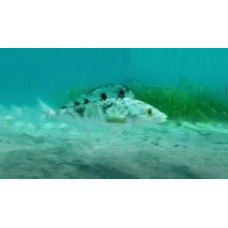Latin name
Pleurogrammus monopterygius
Other name
Pleurogrammus monopterygius
Identification
The body of the Atka mackerel is elongated, somewhat compressed at the sides. There are five lateral lines along the sides of the body. Between the 3rd and 5th lateral line there are 7-9 scales. The second lateral line has 143-162 pores. The third lateral line is short, not reaching the end of the anal fin; the fourth lateral line is also short, not extending beyond the vertical of the end of the pectoral fin. The first and fifth lateral lines diverge at the caudal peduncle and reunite in front of the caudal fin. Vertebrae 59-60.
Features of fish fins
Dorsal fin one long, with 21 rigid, unbranched rays and 25-29 soft rays, barb and soft parts not separated by a notch. Anal fin with 1 barb and 24-26 soft rays.
Fish colouring
Dorsum of Atka mackerel dark olive; dark stripes brownish-olive, light stripes golden yellow to reddish-orange with coppery tinge. Dorsal fin deep gray with a narrow black border. Underside of head and belly yellow.
Distribution
Widespread in the northern part of the Pacific Ocean. Along the Asian coast - from the southern Kuril Islands along the east coast of Kamchatka to Anadyr Bay and Cape Navarin in the Bering Sea. Occurs in the northern part of the Sea of Japan, in the Sea of Okhotsk and near the Commander Islands. Along the American coast - from the Aleutian Islands and the Gulf of Alaska to California.
Habitat
A northern bottom-dwelling fish. Depth range from 0 to 720 meters.
Size
Maximum length of males is 56.5 cm, females - 35 cm. Body weight - up to 2 kg. The maximum life expectancy is 15 years.
Behavior
This species inhabits the benthic zone and near the surface over reefs and hard bottom from the intertidal zone to about 2,360 feet. Atka mackerel are characterized by diurnal vertical migrations.
Food and feeding habits
Juveniles and adults feed on zooplankton, primarily euphausiids. The diet may also include benthic organisms and fish eggs, including their own. Large individuals also consume juvenile fish such as walleye pollock (Theragra chalcogramma).
Reproduction
Males mature at 4-5 years, females at 5 years. Spawning dates vary according to habitat: June-September (east coast of Kamchatka and northern Kuril Islands), May-August (Commander and Aleutian Islands), November (Gulf of Alaska). Spawning is parietal, females can lay 3-4 clutches of eggs (up to 12). Fecundity from five to 120 thousand eggs.
Eggs are bottom dwelling, sticky and are laid in large quantities in crevices of rocky or stony bottoms at depths of up to 20 m. The male guards the clutch for 30-45 days until the larvae hatch. Larvae and juveniles lead a pelagic lifestyle and are carried long distances by ocean currents. At 2 years of age, they move closer to shore and adopt a benthic lifestyle.
Fishing
This species is commercially important. Atka mackerel is fished by the USA and Russia. It is harvested with bottom trawls.
Relationship with a person
Harmless.
| Classification | |
| Phylum | Chordata |
| Class | Actinopterygii |
| Squad | Perciformes |
| Family | Hexagrammidae |
| Genus | Pleurogrammus |
| Species | P. monopterygius |
| Features | |
| Conservation status | Not Evaluated |
| Habitat | Bottom |
| Life span, years | 15 |
| Maximum body weight, kg | 2 |
| Maximum length, cm | 56,5 |
| Sailing speed, m/s | No information |
| Threat to people | Edible |
| Way of eating | Predator |
Atka mackerel
Tags: atka mackerel

